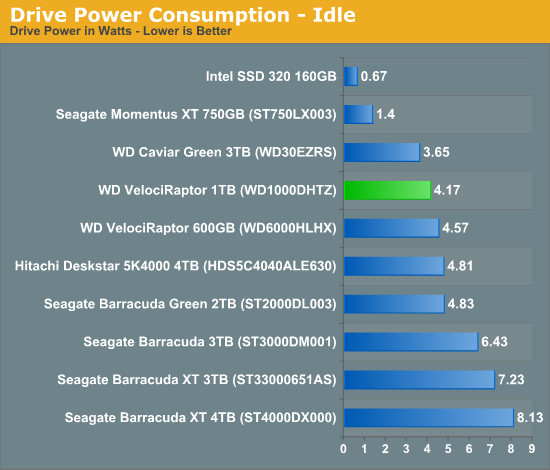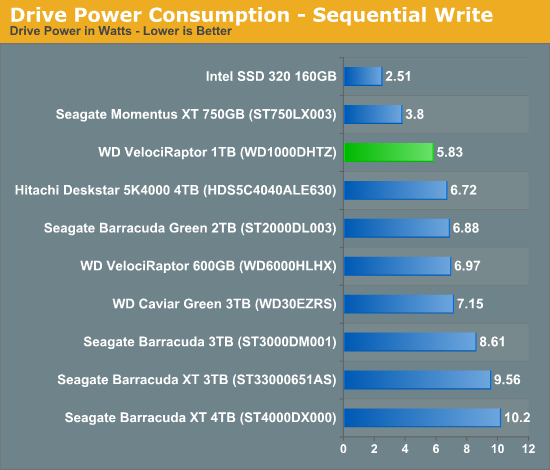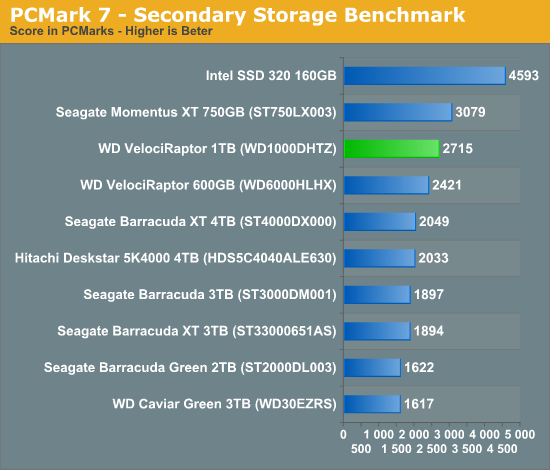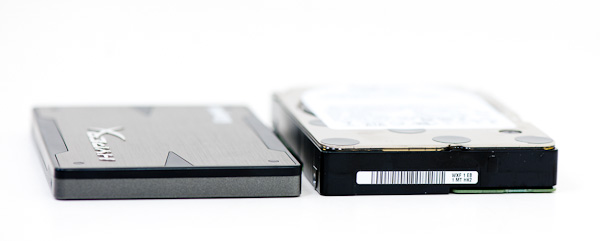Western Digital VelociRaptor 1TB (WD1000DHTZ) Review
by Anand Lal Shimpi on April 16, 2012 8:00 AM EST- Posted in
- Storage
- HDDs
- Western Digital
- VelociRaptor
PCMark 7 Performance
For workloads that are particularly read intensive and small enough to make good use of the on-board NAND, the Momentus XT cannot be beat. The VelociRaptor does come very close however, and it does win in enough other benchmarks to make it clearly the better overall performer. Philosophically I understand why Western Digital opted against equipping the VR with any NAND (cached operations do sort of defeat the purpose of having a 10,000 RPM spindle speed), but that doesn't change the fact that it would've made for one pretty impressive hard drive.
Power Consumption
Despite its 2.5" form factor (the drive itself), the VelociRaptor's 15mm height prevented it from being used as a notebook drive. Even if you had a thick enough notebook, the VR's power consumption is more in-line with a 5400RPM 3.5" drive than a standard 2.5" mobile drive. That being said, as a 10,000RPM 3.5" drive the VelociRaptor is quite power efficient. Idle power is competitive with WD's Caviar Green (and lower in the case of load power).
Power consumption is down compared to the previous generation as well. Once again, compared to an SSD however the drive isn't anywhere near efficient.














92 Comments
View All Comments
JarredWalton - Monday, April 16, 2012 - link
15K drives are exclusively SAS/SCSI, and capacities are lower than WD while prices are higher. In fact, the 15k drives are right in SSD territory for price per GB. Looking at Newegg, they range from as low as $1/GB to around $2.50/GB, with maximum capacity topping out at 600GB. A 512GB Crucial m4 will only cost around $550, for example. Still, for enterprise workloads you'd need an enterprise HDD most likely. Anyway, I've clarified the statement to say "mainstream 10k" -- we know 15k has been around for enterprise for ages. One might argue that the reason WD even came out with the Raptor is that they didn't have a 15k enterprise offering to protect.Sabresiberian - Monday, April 16, 2012 - link
Name them.The only 10-15k hard drives to exist before the VR were SAS drives; if you think these are expensive, check out the price of SAS drives. (They are quite a bit cheaper than they used to be, too.)
;)
jabber - Monday, April 16, 2012 - link
My old Mk2 75GB Raptor sit as the OS drive for my gaming rig. Noisy but still surprises me now and then.I have moved my Gf over to SSD tech but I haven't as yet. If I got SSD in one machine I'll want them in all my machines and I just cant afford that.
Would like to see some testing of this with a 40GB cache drive just for giggles.
Denithor - Monday, April 16, 2012 - link
Actually, this is a fantastic suggestion.Look at whether there's any advantage to a VR + 40GB cache SSD versus a typical 1TB 7200 with the same cache drive.
Golgatha - Monday, April 16, 2012 - link
2x500GB or 1TB in RAID0Faster, cheaper, but somewhat less reliable due to RAID0. If you have space for 2 drives, I think the RE4 line is a much, much better value.
marraco - Monday, April 16, 2012 - link
And a 100 Gb partition for OS would use the 5% faster sectors, which runs around 210 Mb/s (more than 400 Mb/s in RAID0). That partition would also be short stroked, so 4kb random should give good numbers for an HDDShadowmaster625 - Monday, April 16, 2012 - link
I dont care if it is just one 8GB MLC chip, with 67% of the chip reserved for wear leveling. Even just 2GB of flash would make the poor random I/O performance much more bearable, and bring this close to Momentus XT type performance.magreen - Monday, April 16, 2012 - link
"The advantage of the NAND equipped Seagate Momentus XT is just as large."That should read the "advantage over the NAND equipped...," correct? It seems to say the opposite of what you mean right now.
MrSpadge - Monday, April 16, 2012 - link
"If users are able to fit all of their program, apps and data into a 128GB SSD, I have to believe that a well managed cache can deliver compelling performance with half that space."It definitely does. Using an Agility 3 60 GB as cache with SRT.
sixmoon - Monday, April 16, 2012 - link
Hi, I enjoyed the review, I somehow got tired of all the SSD reviews lately. I somehow expected this drive was going to be compared with SSD's and this is fair, however if you compare it to the new generation of 3-4TB, this HDD really doesn't find its place anymore. It's more expensive and smaller, and in the HDD world, being smaller also affects performance.I find the new Hitachi 7k4000 drive to be on par with the new Velociraptor, take a look here: http://macperformanceguide.com/Storage-Drive-Hitac...